Explore the difference between digital twin of the customer (DToC) and traditional customer personas. Discover how real-time, AI-driven insights are replacing static models to deliver personalized customer experience and higher marketing ROI.
The marketing world moves at the speed of a double-tap. Staying in sync with your audience isn’t just an advantage, it’s your survival kit. And yet, so many brands are stuck with traditional customer personas that look good in slideshows but do not work in real life.
In today’s hyper-connected digital space, customers evolve overnight. Your understanding of them needs to be just as agile.
resonaX flips this script. Meet the Digital Twin of the Customer (DToC): your always-on, AI-powered mirror of real human behavior. Where personas are painted by numbers, DToC is living, breathing nuance. So what does this mean for you, the modern marketer? Let’s jump in.

Defining Traditional Customer Personas
Traditional customer personas are fictitious depictions of particular target audience categories. Built using demographics (age, gender, income), psychographics (interests, values), and behavioral data (purchase history), they aim to simplify and guide marketing efforts.
Example:
We’ve all met the “Emily” of marketing, a persona who is 35, shops online twice a week, and loves eco-friendly brands. Sure, she’s easy to present, but does she feel real? Does everyone act like her? Not quite.
These personas are helpful for basic segmentation and campaign targeting. However, their static nature fails to provide for the evolving behavior and context of real customers in a data-driven, digital world.
Limitations of Traditional Personas
- Outdated quickly: Traditional customer personas are built using snapshots of data collected at a specific time. They stay that way, until your next ‘refresh’ meeting.
- Low predictive power: Such data-driven personas offer insights based on past behavior, not real-time or future actions.
- One size never fits all: Not all 35-year-old working individuals behave the same.
- No adaptability: Traditional customer personas don’t account for changes like mood, environment, or lifecycle stages.
In short, traditional personas don’t reflect how customers behave now, or how they will.
Defining Digital Twin of the Customer (DToC)
A Digital Twin of the Customer (DToC) is a dynamic, virtual model of an individual customer, a digital brain, built using real-time data, psychology, AI, machine learning, and behavioral analytics. Unlike static personas, DToCs continuously learn and adapt based on how the customer interacts with your brand, online and offline.

Key Elements of DToC
The Digital Twin of the Customer is more than just a digital profile, it’s a powerful fusion of customer digital twin technology and AI that enables real-time, personalized engagement. Here’s how it works:
- Live behavioral data
DToC constantly collects real-time data seamlessly, including browsing habits, app activity, click patterns, and support interactions. This ongoing behavioral segmentation helps create data-driven personas that evolve with each customer action.
- AI-Driven Personalization
By applying AI in customer insights, DToC uses machine learning to understand and predict what a customer might do next, like making a purchase, leaving a site, or requesting help. This form of marketing personalization AI helps businesses connect with customers in the right way, at the right time.
- 360° Customer View
Traditional models often miss the full picture. DToC builds next-gen customer profiles by combining transactional, emotional, social, and even environmental data. This gives businesses a complete view and enables a more personalized customer experience across every channel.
- Predictive Modeling
Thanks to advanced customer data analytics, DToC can forecast customer behavior, whether it’s identifying those at risk of leaving, spotting upsell opportunities, or planning better experiences using customer journey simulation. These predictions help businesses stay one step ahead.
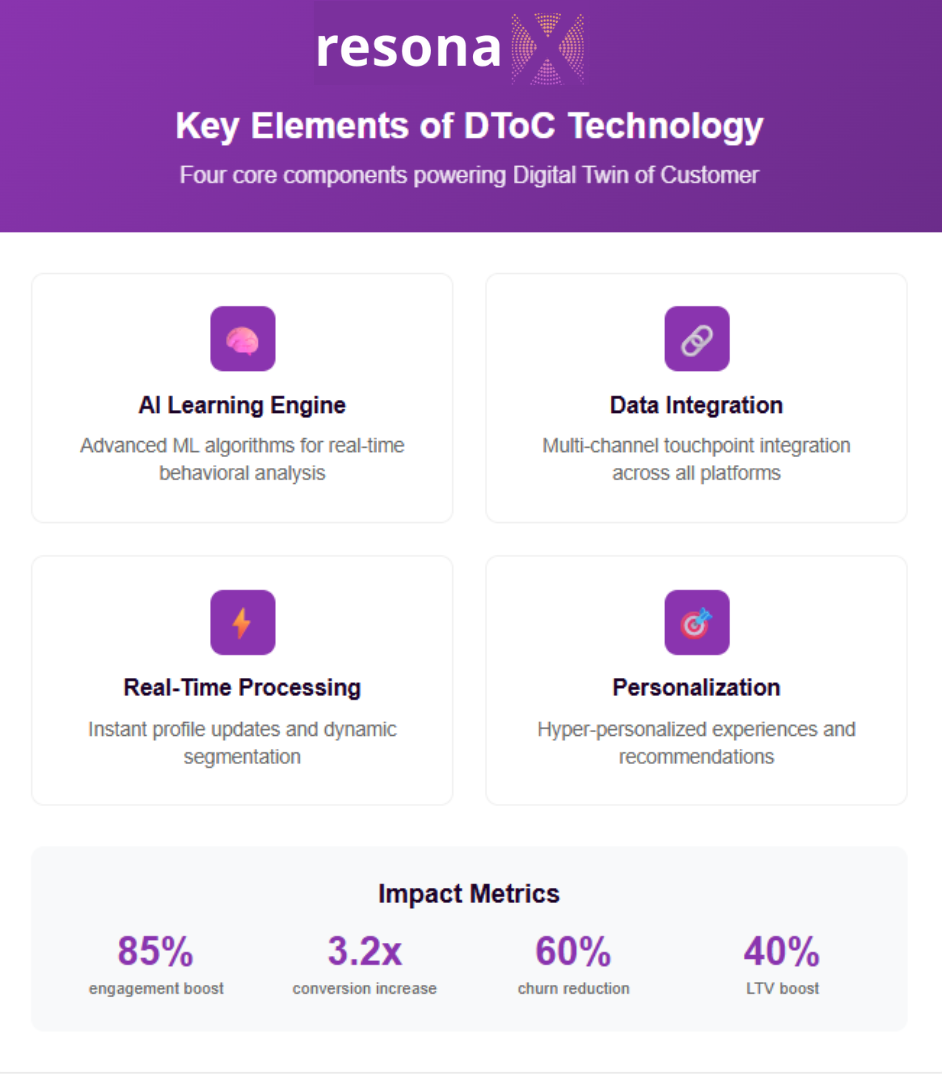
Altogether, DToC transforms basic customer segments into dynamic, real-time models, reshaping how brands understand and engage with their customers every step of the way.
According to Gartner, by 2025, more than 60% of global enterprises will use DToC technologies to better simulate and influence customer behavior.
Let’s compare: DToC Vs Traditional Customer Personas
| Feature | Traditional Personas | Digital Twin of the Customer (DToC) |
| Nature | Static | Dynamic & evolving |
| Data Sources | Surveys, historical data | Real-time, multi-channel data |
| AI Integration | Rare | Core component |
| Predictive Capabilities | Low | High (anticipates behavior) |
| Personalization | Generic | Hyper-personalized |
| Adaptability | Needs manual updating | Continuously updates via automation |
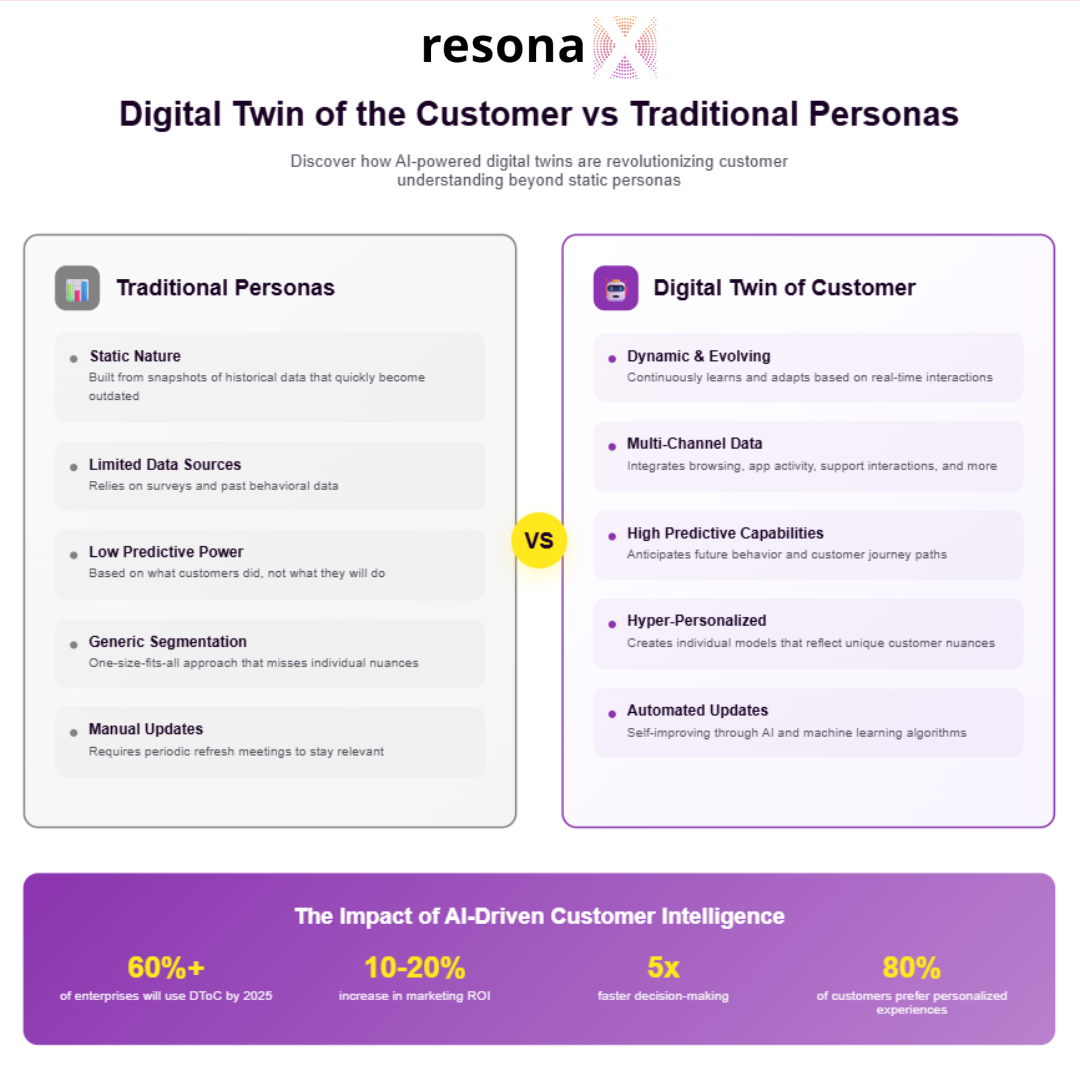
This shift from traditional customer personas to digital customer modeling reflects a broader trend towards data-driven personas and predictive customer behavior analysis.
Why DToC outperforms Traditional Personas
1. Enhanced marketing ROI
By leveraging AI in customer insights and marketing personalization AI, DToC enables real-time, tailored campaigns that resonate with individual customers. This precision reduces ad spend wastage and boosts conversion rates.
Organizations investing in AI-driven marketing and sales have seen a 10–20% increase in ROI.
— McKinsey
2. Improved customer retention and loyalty
DToC’s integration of customer data analytics and behavioral segmentation allows businesses to identify early signs of customer churn and proactively engage with personalized solutions, enhancing the personalized customer experience.
According to 76% of consumers, businesses should be aware of their wants and needs.
— Salesforce
3. Predictive customer behavior insights
Utilizing customer journey simulation and next-gen customer profiles, DToC anticipates future customer actions, enabling businesses to address needs before they arise.
Companies employing predictive analytics achieve 5x faster decision-making and 33% higher accuracy in customer targeting.
— Accenture
By adopting customer digital twin technology, businesses can transition from reactive strategies to proactive engagement, ensuring they meet and exceed evolving customer expectations.
The shift towards real-time customer modeling
As digital experiences grow more complex, the pressure on businesses to deliver personalized customer experiences has never been higher. According to a recent Deloitte study, 80% of customers are more likely to purchase from brands that offer tailored experiences.
Beyond simple segmentation, organizations must embrace data-driven personas driven by customer digital twin technology in order to meet this need. In this context, DToC vs traditional customer personas isn’t just a technological comparison, it’s a strategic imperative.
While traditional models rely on outdated snapshots, Digital Twin of the Customer (DToC) systems leverage customer data analytics, behavioral segmentation, and AI in customer insights to adapt to user needs in real time.
This shift empowers brands to create next-gen customer profiles, drive predictive customer behavior analysis, and implement more effective marketing personalization AI strategies. In essence, DToC helps businesses evolve from guessing to knowing, and from reacting to anticipating.
DToC across industries
The Digital Twin of the Customer (DToC) isn’t just a futuristic concept, it’s already transforming how industries approach personalization, prediction, and customer engagement. By combining AI in customer insights, behavioral segmentation, and customer digital twin technology, DToC enables real-time, adaptive solutions that go far beyond what traditional customer personas can offer.
SaaS & Digital Products
Digital Twin of the Customer (DToC) assists brands in transitioning from static assumptions to predictive customer behavior modeling in the rapidly changing SaaS landscape.
- Makes it possible to create next-gen customer profiles that show churn indications, engagement levels, and product usage in real time.
- Uses AI in customer insights to customize in-app experiences, feature adoption, and onboarding.
- Supports behavioral segmentation for customer success interventions, renewal nudges, and data-driven upselling.
SaaS companies may proactively mould the user journey, provide individualized customer experiences, and promote sustainable growth at scale by utilizing customer digital twin technology.
Retail & eCommerce
In fast-moving consumer environments, DToC helps brands move beyond static customer personas to create data-driven personas that evolve continuously.
- Product recommendations that are tailored to each user’s browsing and purchasing habits
- Dynamic pricing and bundling, informed by predictive customer behavior and customer data analytics
- Enhanced personalized customer experience throughout the buying journey
Healthcare
DToC brings a new layer of intelligence to patient care through customer journey simulation.
- Simulates patient behavior and journeys for early diagnosis and preventive interventions
- Predicts medication adherence and follow-up needs using next-gen customer profiles
- Supports patient-centric care models with real-time data
Banking & FinTech
With real-time modeling, financial services can respond faster and smarter.
- Dynamic risk profiling for credit scoring using AI in customer insights
- Detecting fraud in real time by monitoring unusual consumer behavior
- Better upsell/cross-sell predictions based on predictive customer behavior
Travel & Hospitality
In industries where preferences change quickly, DToC empowers businesses to react instantly.
- Suggests customized itineraries based on recent searches, locations, and preferences
- Anticipates cancellations, upgrades, or changes with customer journey simulation
- Improves guest loyalty and satisfaction through adaptive personalization
Across all these industries, DToC vs traditional customer personas is a clear win — enabling continuous, personalized, and predictive engagement through digital customer modeling.
The future of personalization is DToC
In a world where customer expectations evolve in real-time, clinging to outdated, generic profiles can cost brands their relevance. The Digital Twin of the Customer marks a shift from assumptions to adaptive intelligence, unlocking AI in customer insights, behavioral segmentation, and predictive customer behavior like never before.
With DToC, businesses can:
✔ Build next-gen customer profiles
✔ Simulate full customer journeys
✔ Deliver truly personalized customer experiences
✔ Maximize returns with smarter, data-driven marketing strategies
Ready to go beyond traditional personas?
Whether you’re in retail, healthcare, banking, or travel, the future belongs to brands that test, learn, and optimize with real customer twins—not static assumptions.
Start your journey with the Digital Twin of the Customer (DToC) powered by resonaX.ai:
- Deliver hyper-personalized experiences
- Drive smarter engagement, retention, and growth
Enhance marketing with resonaX.ai
Ready to break free from generic campaigns? resonaX.ai hands you the controls to step beyond flat personas and into the world of living, breathing customer twins—so every campaign, email, or product launch is backed by data-driven confidence. Harness the power of Digital Twin of the Customer (DToC) technology to transform static assumptions into precise, real-time next-gen customer profiles.
By blending customer data analytics with its proprietary digital twin modeling, resonaX.ai ensures every marketing interaction be it an ad, email, or landing page is hyper-personalized and validated in real time.
What’s in it for marketers?
For marketers, the value of resonaX lies in one thing: confidence before launch. Instead of spending budget on campaigns that may or may not work, you get a safe testing ground with digital twins of your ideal customers.
- Test, learn, optimize – Interact with the hyper-realistic digital twins to test and refine messaging, campaigns, emails, social posts, ad copy, product positioning, any marketing idea and see what works before spending a dollar.
- Personalize at scale – resonaX creates AI-powered customer twins from LinkedIn profiles or your customer data, letting you tailor campaigns that feel genuinely human. No robotic segmentation—just messaging that clicks because it’s been tested on lifelike customer models.
- Simulate the customer journey – With resonaX, you can map out how a real prospect would move through your funnel. Test different touchpoints, offers, or sequences and see the most likely path—before rolling it out to your audience.
- Predict and prevent churn – resonaX twins reveal friction points and disengagement signals early, so you can fine-tune retention strategies, craft renewal nudges, and intervene before a customer leaves.
- Drive engagement that lasts – By continuously learning from every simulated interaction, resonaX ensures your campaigns build not just conversions, but loyalty and trust that compounds over time.
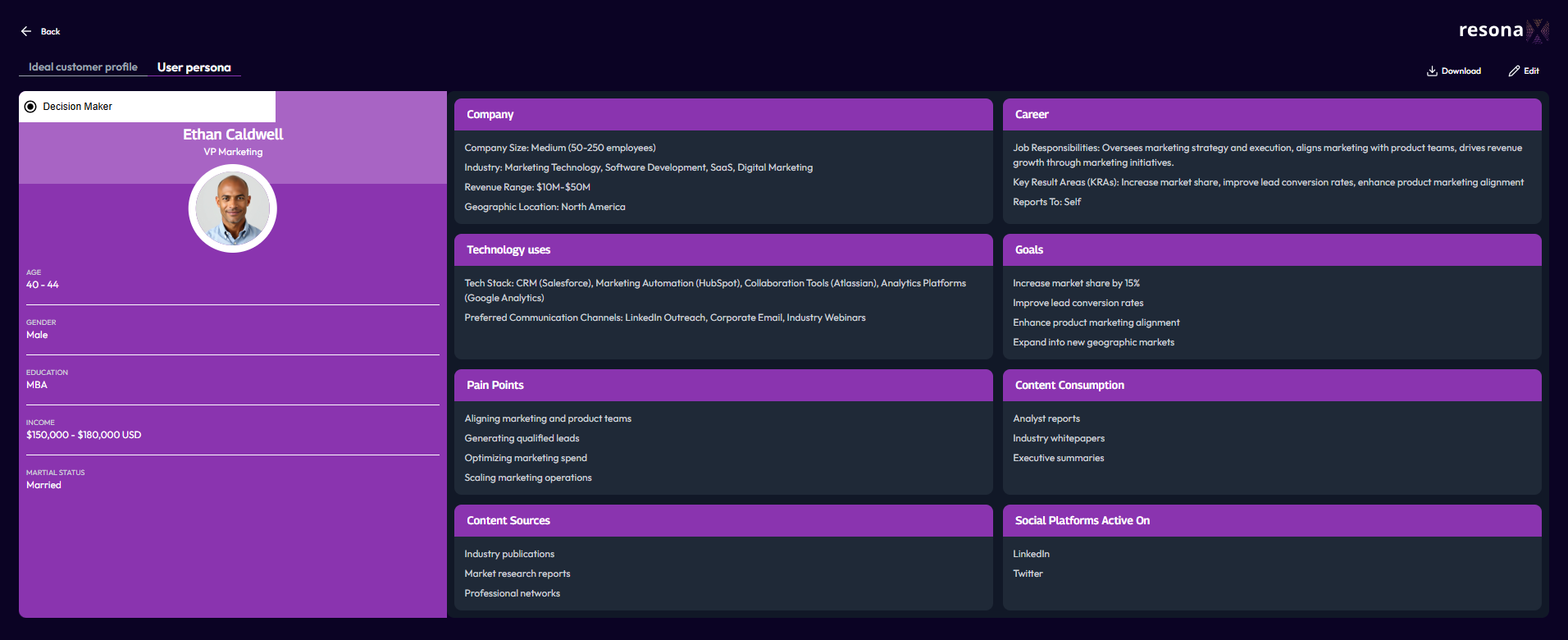
How resonaX.ai Creates Digital Twins for Customers
At resonaX, building a digital twin of your customer doesn’t start with guesswork—it starts with the data you already have. Whether it’s a LinkedIn profile, CRM records, website activity, or support conversations, resonaX brings these signals together to create a living, breathing version of your customer.
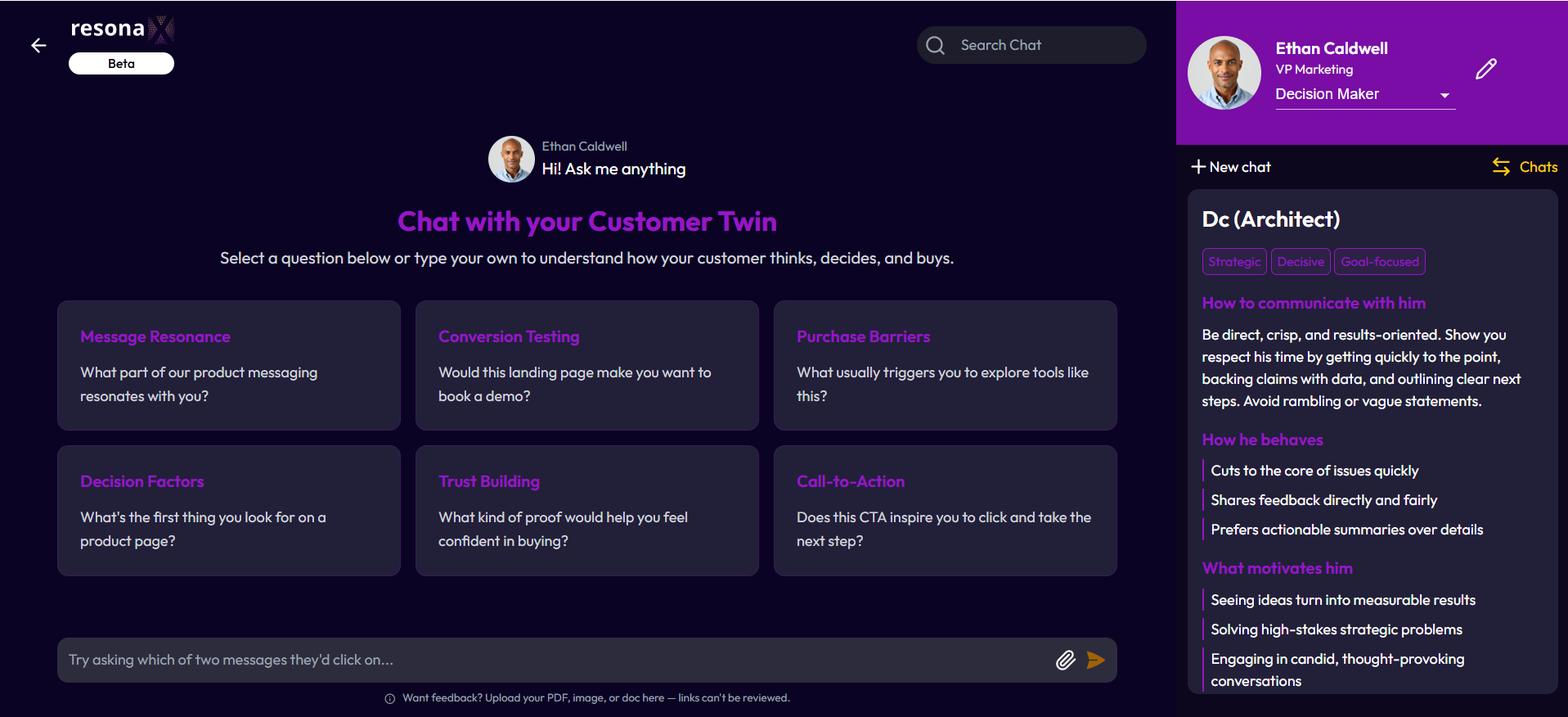
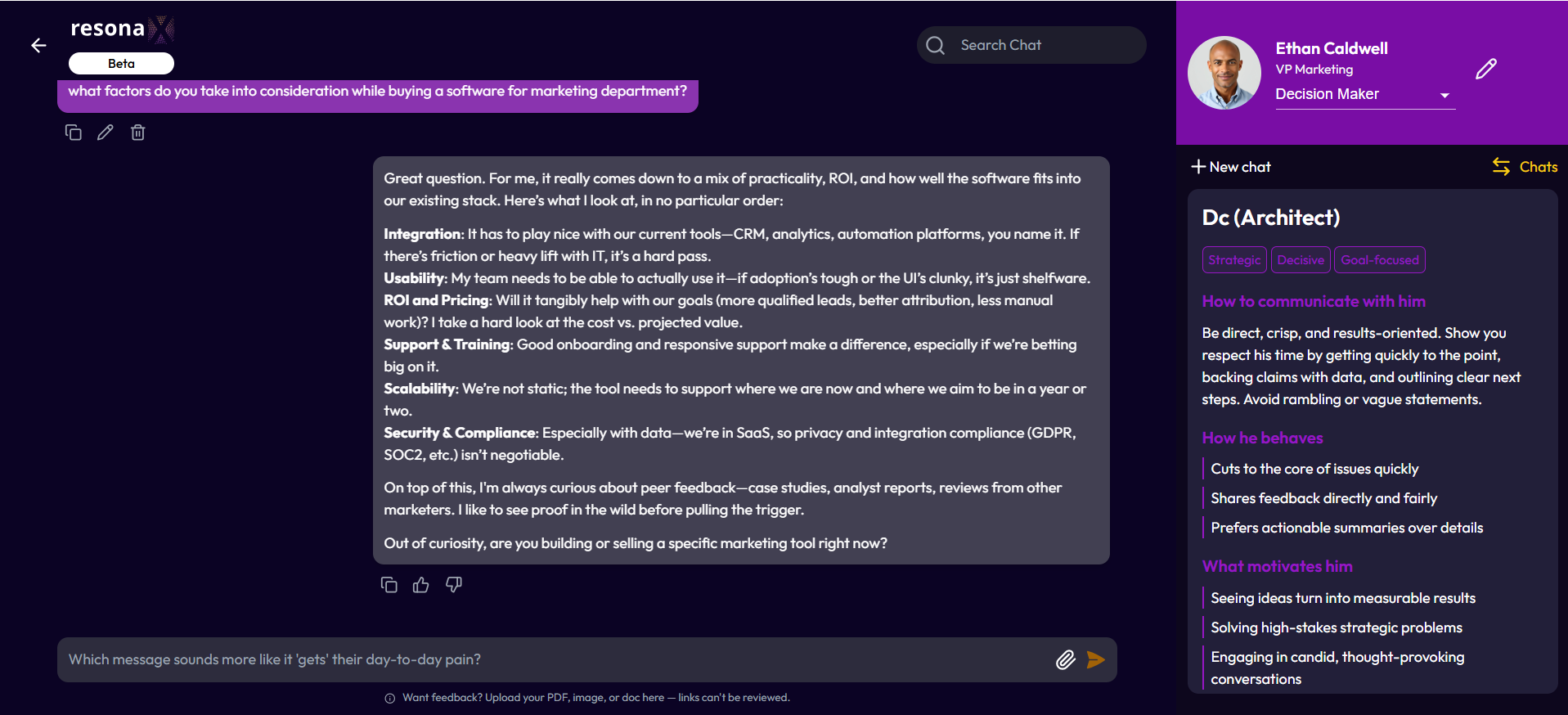
These digital twins aren’t static snapshots; they continuously evolve in real time, learning from every click, call, and interaction. Every click, message, or interaction helps refine the twin, so it reflects not just who your customers are, but how they think, decide, and change over time. . This empowers marketers to confidently test messaging, model customer decision-making, and deliver personalized products or offers at scale.
For marketers, this means you can:
- Test campaigns before launch and know what will resonate.
- See customer decisions play out without risking real budget.
- Personalize at scale in ways that feel authentic.
The result? A faster, smarter way to design marketing that actually connects—because it’s based on how your customers really behave, not on assumptions.
Interested in how resonaX’s digital twin technology can help you create marketing that resonates with your audience every time? Let’s start the conversation today.
References:
- Gartner (2022): By 2025, 60%+ of enterprises will use Digital Twin tech to simulate customer behavior.
- McKinsey (2023): AI-driven marketing boosts ROI by 10–20%.
- Salesforce (2022): 76% of customers expect companies to understand their needs.
- Accenture (2021): Predictive analytics leads to 5x faster decisions and 33% better targeting.
- Deloitte (2022): 80% of customers prefer personalized brand experiences.
